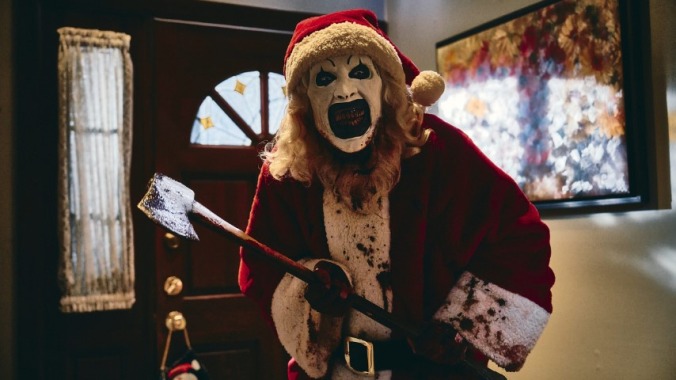Terrifier 3 and Art the Clown’s Violent Self-Indulgence

If it is your experience that society has devolved into a considerably more selfish place compared to, oh, let’s say 5 years ago, then good news: You’re not alone. Science shows us, dating back to summer 2020, that people have grown increasingly insolent in recent memory, and although that same science can’t quite agree on why, research and the power of observation demonstrate that “me first, gimme gimme” is indeed the ethos driving scads of folks in 2024. Call it a marker of life in a post-COVID world, or a post-truth world, or a consequence of tolerating social media saturation; whatever the reasons, the outcomes are self-explanatory.
Of all the areas where this rise in cultural self-interest can be traced, horror cinema is perhaps a lower rung compared to, for instance, presidential politics. But horror reflects the collective consciousness, and thus is primed to communicate the fears and anxieties burrowed in our psychoses. The implicit corollary of this effect, that horror shows us what we’re afraid of, is that horror also ultimately gives us the monsters we deserve. And we deserve Art the Clown.
The venial sins of selfishness–refusing to hold the door for strangers, tipping waiters stingily, cutting cars off in bumper-to-bumper traffic, being a dick to strangers as you livestream–are a far cry from the protracted atrocities Art subjects hapless victims to in Damien Leone’s Terrifier films, including, but not limited to, sagittal bisection, flogging, flaying, acid attacks, amateur knifepoint penectomies, cannibalism, and bludgeoning, all conducted using homemade weapons or rusty hardware. (For a lucky few, Art resorts to guns.) But what Leone makes clear across each of these movies, and what David Howard Thornton, the man behind the harlequin makeup, expresses through his performance, is how much delight Art takes in killing. Going by the KonMari method, savage violence is absolutely what sparks joy.
Art isn’t the first of slasher cinema’s masked villains to derive if not joy, then at least a hearty belly laugh, from painfully shuffling people off of their mortal coils. Charles Lee “Chucky” Ray and Freddy Krueger are ur-texts for Art’s background; both of them like murdering people, and both of them go deep in the tank to devise new, creative ways to take life. (Krueger has a noticeable edge in this contest, but you gotta respect Chucky’s industriousness.) Think of either character; the first thing that comes to mind is likely to be their appearances, but the second thing is equally as likely to be their echoing cackles, which are as core to their personas as the accouterments we associate with their names. Contrasted with genre-defining silent lumbering beefcakes, like Leatherface, Michael Myers, and Jason Voorhees, Chucky and Freddy’s sadistic delight is a pleasant anomaly.
-

-

-

-

-

-

-

-

-

-

-

-

-

-

-

-

-

-

-

-

-

-

-

-

-

-

-

-

-

-

-

-

-

-

-

-

-

-

-

-








































